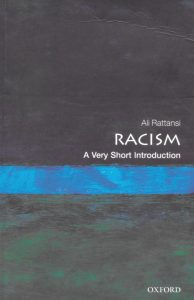The one-sentence summary
Racism is a poorly understood concept but with careful thought and unbiased analysis it can be demystified to some extent, allowing us to understand the roots of the phenomenon and challenge its new forms.
Can’t be bothered to read it? Listen to the 5-minute podcast in two parts.
WHAT THE BOOK SAYS 
- From subtle discrimination in everyday life to lynchings, cultural imperialism and ethnic cleansing, racism exists in many forms in almost every facet of society. But what exactly is race? How are race, ethnicity and xenophobia related? Is Islamophobia racist? Why has there been a resurgence of national populist and far-right movements?
- This 2020 edition has been updated from 2006, but depressingly most of the issues remain and some have got worse. Continuing themes include the emphasis on the varying degrees of ambivalence and contradiction in racist identities, and the concept of racialization in the analysis of racism.
- Racism is multidimensional and it evolves to insinuate itself effectively in cultures of discrimination. The term ‘racist’ hinders rather than helps in understanding how minorities and outsiders are racialized.
- Significant areas of debate include:
- Certain types of Islamophobia might be regarded as forms of racism, but can a combination of religious and other cultural antipathy be described as racist?
- Intersectionality is important. This field of research covers in its framework an understanding that age, disability and citizenship have as much effect as race, class and gender – they can all be interrelated, to the point where focusing solely on race can be too simplistic and unhelpful.
- ‘Colourblind’ racism often prevails. This view asserts that there are no real problems with racism in our society and that challenges stem from individuals or institutions. This is a form of defence of the status quo.
- A narrow definition of racism lacks the suppleness to grasp how issues such as national populism and nativism carry a deeper racial charge than is often understood.
- Developments following the decoding of the human genome have led to astonishing leaps in understanding of how significant the mixing of populations has been in the past, so that inhabitants that make native claims in particular territories have seldom been the first or original settlers, thus comprehensively undermining their nativist narratives.
- Early settlers in Europe had dark skins, dark enough for them to be described in contemporary terms as ‘black’. This completely overturns the way in which Europeans have usually claimed that to belong to Europe individuals have to be white. This also applies to the notion that, to be genuinely American, whiteness is essential.
- Analysis of ancient DNA also has serious implications for claims by Hindu nationalists that they have some sort of original purity – there are no ‘pure’ biological populations. We are all the product of multiple migrations and mixtures.
- We once again find ourselves in a time when a serious understanding of ‘race’ and racism is urgent.
- The rise of right-wing national populism carries dangers that were last seen in the rise of Nazism and other forms of fascism which we thought would never appear again. The foundations of liberal democracies even in well-established countries are experiencing an erosion of many fundamental institutional checks and balances against authoritarian rule.
- Racist forces have been emboldened by the rise of this right-wing authoritarianism, reflected in increased hate speech and physical assaults. Public racist proclamations and violent racist acts are on the move from the margins to the mainstream in many parts of the world.
- Racism is a seemingly never-ending saga.
